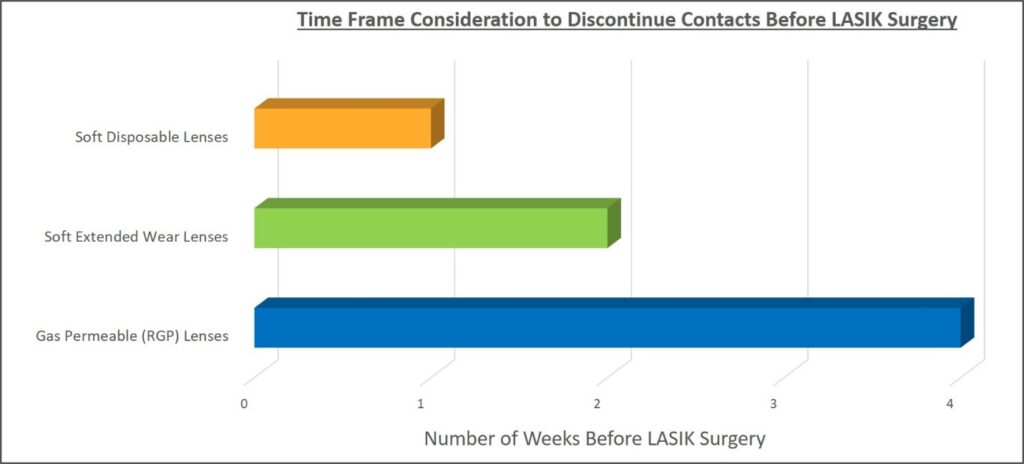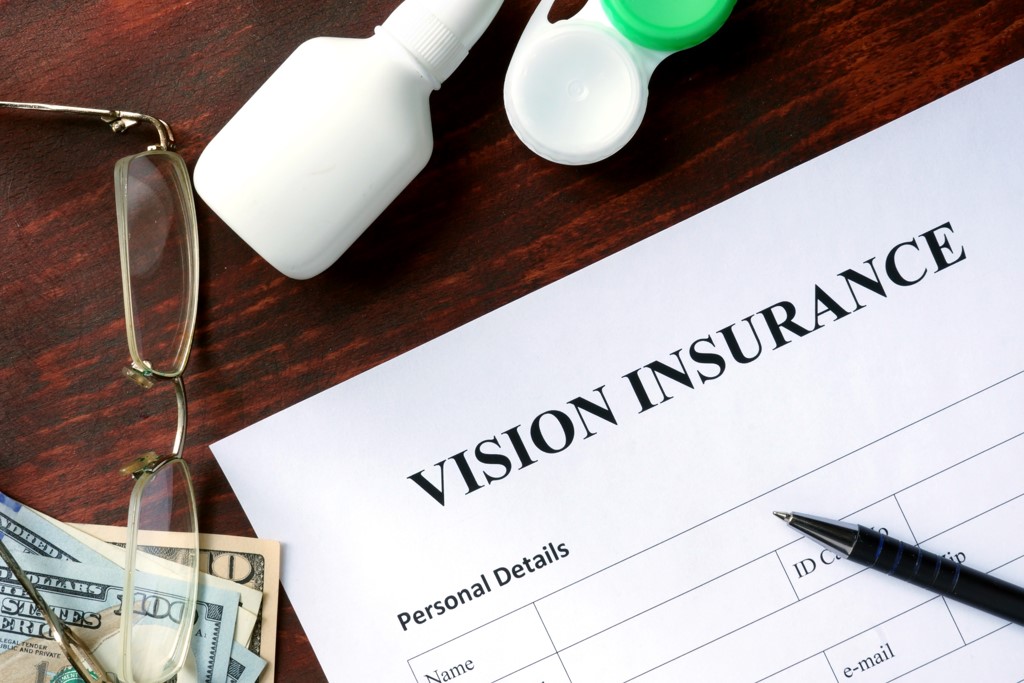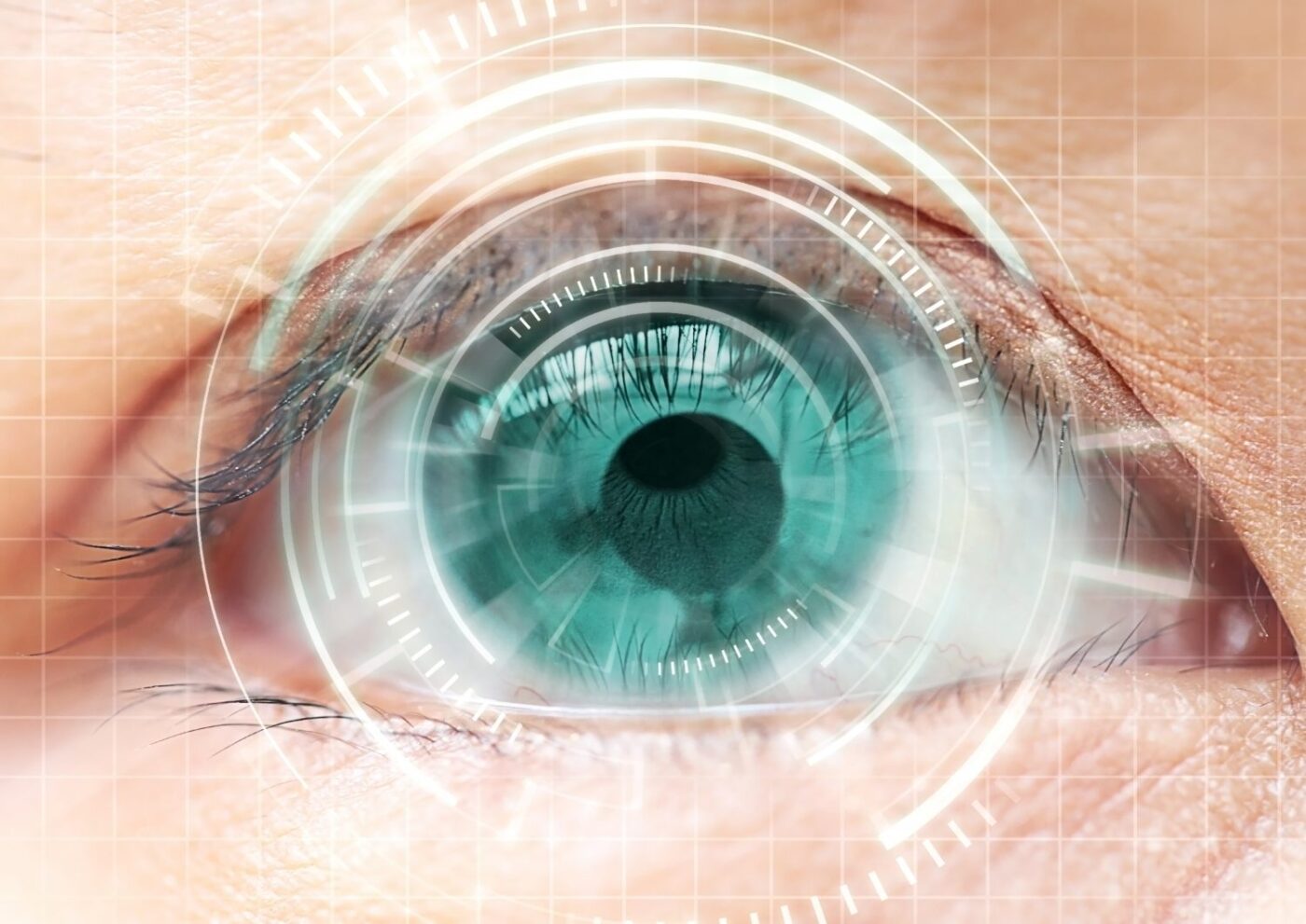
Making the decision to have LASIK is a life changing decision. If you have decided to experience clearer vision through LASIK eye surgery, you are probably excited about the prospect to break your reliance on glasses or contacts. It’s also normal to be curious, and even a bit nervous, about your upcoming LASIK procedure. Be prepared for your LASIK experience by reading about what to expect on the day of your LASIK eye surgery.
Preparing for your LASIK procedure
Depending on the type of contact lenses and if they are prescribed to be worn overnight (ie, extended-wear contacts), contacts may alter corneal shape for up to several weeks after you discontinue wearing contact lenses. Thus, it is recommended to stop wearing contact lenses before your pre-operative baseline exam and before the day of LASIK procedure.
Prior to your pre-operative examination and your LASIK surgery, it is generally recommended to stop contacts for 1 week with soft disposable contacts, 2 weeks with soft extended-wear contacts, and 4 weeks with gas permeable (RGP) lenses. However, after your pre-operative baseline exam, your LASIK specialist will give your specific instructions on the exact timeframe to discontinue your contact lens wear.

There are no restrictions on eating, so you do not need to fast prior to a LASIK procedure. You can also take any regular medications, as long as you had previously cleared these with your LASIK provider. However, you should not consume alcohol on the day of your procedure.
Since your eye area will be cleaned prior to LASIK, you should not wear any eye makeup on your surgery day. In addition, it is also best to avoid wearing perfume or cologne before arriving for your LASIK procedure. Because the LASIK procedure room is kept at a cool temperature, it is best to dress yourself in casual wear that will keep you warm and comfortable.
Your pre-operative treatment regimen will vary depending on your pre-operative examination. Some patients will be prescribed dry eye treatments, topical and/or oral medications to get them ready for LASIK surgery. Thus, please make sure to follow specific pre-operative instructions customized for you by your LASIK provider.
Arriving at your LASIK provider
Before getting to the LASIK surgery center, confirm that you have pre-arranged transportation to get home after your procedure. Be sure to arrive at your provider promptly and check in. If there is any final paperwork pending, such as informed consent form, you’ll be asked to complete them and return it to the intake professional.
The entire LASIK procedure typically take less than 15 minutes to perform for both eyes while the actual laser treatment time is less than 1 minute per eye. It often surprises patients to learn that these newly optimized lasers can achieve the desired vision correction effects in such short timeframe!
Nonetheless, it is advisable to allocate approximately 2 hours to spend at the surgery center on your procedure day; this will allow time for paperwork completion and for pre-operative medications to take proper effects. For example, you may be offered a mild sedative medication to reduce potential anxiety prior to LASIK treatment. Also, your eye area will be disinfected with an antiseptic solution and numbing eye drops will be applied to the eyes to ensure maximal comfort during LASIK.
During your LASIK procedure
Once you have been prepped, you are ready to head into the LASIK laser suite. You will be lying down on a cushioned surgical bed with an ergonomically contoured headrest that comfortably cradles your head and neck, which helps to reduce your potential head movements during the brief duration of LASIK surgery. If needed, your surgeon may also gently hold your head in desired position to help keep your head steady during the LASIK procedure. Don’t worry, however, our lasers have tracking systems so that if your eye moves the laser will follow your eye.
Numbing eye drops that were applied to your eyes before LASIK will both make the procedure comfortable and decrease your urge to blink. In case you still feel unsure about keeping your eyelids clear of the LASIK treatment area, the lids of the treated eye will be supported and kept open by a small ophthalmic device (“Speculum”) – it does not cause pain but may cause mild sensation of pressure around the eyelids.
You will have one eye covered at a time – patching the fellow eye helps the treatment eye to better maintain fixation under laser. Your surgeon will be monitoring your eye movement with surgical microscopes attached to the laser treatment station. Once s/he ascertains that the treatment eye is in an ideal position, you’ll be asked to focus on a colored target light. The target light is not the laser responsible for correcting your vision, it simply helps you to maintain the direction of your gaze during a treatment session.
Once you fixate at the target light, your surgeon will gently prompt you prior to initiating planned LASIK treatment. The programmed laser sequences, based on the measurement data gathered at your pre-operative exam, will gently reshape your cornea to achieve vision correction.
During this treatment process, you will be aware of new smells and sounds originated from or caused by the operating laser. The excimer laser pulses do not lead to significant rise in tissue temperature (ie, this laser does NOT lead to thermal burn); however, LASIK tissue reshaping process is expected to release a scent that is similar to a singed hair, which is what you smell during this very quick procedure.
Additionally, as part of the expected LASIK treatment course, you can also expect temporary diming in your vision and fluctuating degrees of visual blur while under the laser.
Does Eye Movements Interfere with LASIK?
Some patients are concerned that accidental eye movements during LASIK may interfere with outcome of their vision correction procedure. You should note that your eye movements are monitored during LASIK, both by your surgeon and the sophisticated eye tracking software housed in the laser. Should your eye movements exceed an acceptable level, the eye tracking software will automatically pause the laser treatment sequences until optimal eye position is again achieved.
Thus, while your surgical team and the advanced computer tracking program are working seamlessly to ensure your best LASIK outcome within the shortest possible treatment duration, all you have to do is follow your surgeon’s instructions and look at the assigned target fixation light for less than 1 minute each time! It’s no wonder that patients often remark on how easy and quick their experiences were with LASIK!
After your LASIK procedure
Visual recovery after LASIK is relatively quick and requires no stitches. Immediately after LASIK surgery, you can expect for your vision to be blurry for at least a few hours. It can also be normal to experience temporary eye stinging, scratchiness and light sensitivity. Your doctor will instruct you to close your eyes to rest for a short period of time after surgery and before discharging you to go home.
It is important to avoid irritating or traumatizing your cornea in the early recovery period. Therefore, an eye shield or protective goggle will be placed on your eyes to enhance protection before you leave the laser clinic.
Because the sedative given immediately before LASIK can also impair your ability to drive, please make sure that you have arranged for reliable transportation to get home after LASIK surgery, because you will not be allowed to drive yourself home immediately after procedure.
Although majority of patients are comfortable, some may experience discomfort or mild pain. In the latter cases, your doctor may suggest a short course of over-the-counter or prescription pain reliever such as Aspirin, Motrin, or Aleve to help you be as comfortable as possible in early recovery period.
Once you have safely arrived home, plan to rest your eyes for the remainder of the day. Taking a nap after getting home is always highly recommended. The first night, it is recommended that you sleep on your back while wearing the protective eye shield. Over the next 24 to 48 hours, you’ll likely be able to resume most of your normal daily activities. During the first week, as your eyes continue to heal with improving vision, you should also follow your doctor’s instructions on taking eye drops to help the healing process, sleeping with the protective eye shields and staying away from vigorous physical activities. Learn more about after LASIK care.
If you’d like to find out if you are a candidate for LASIK, schedule a free consultation at a location near you.


